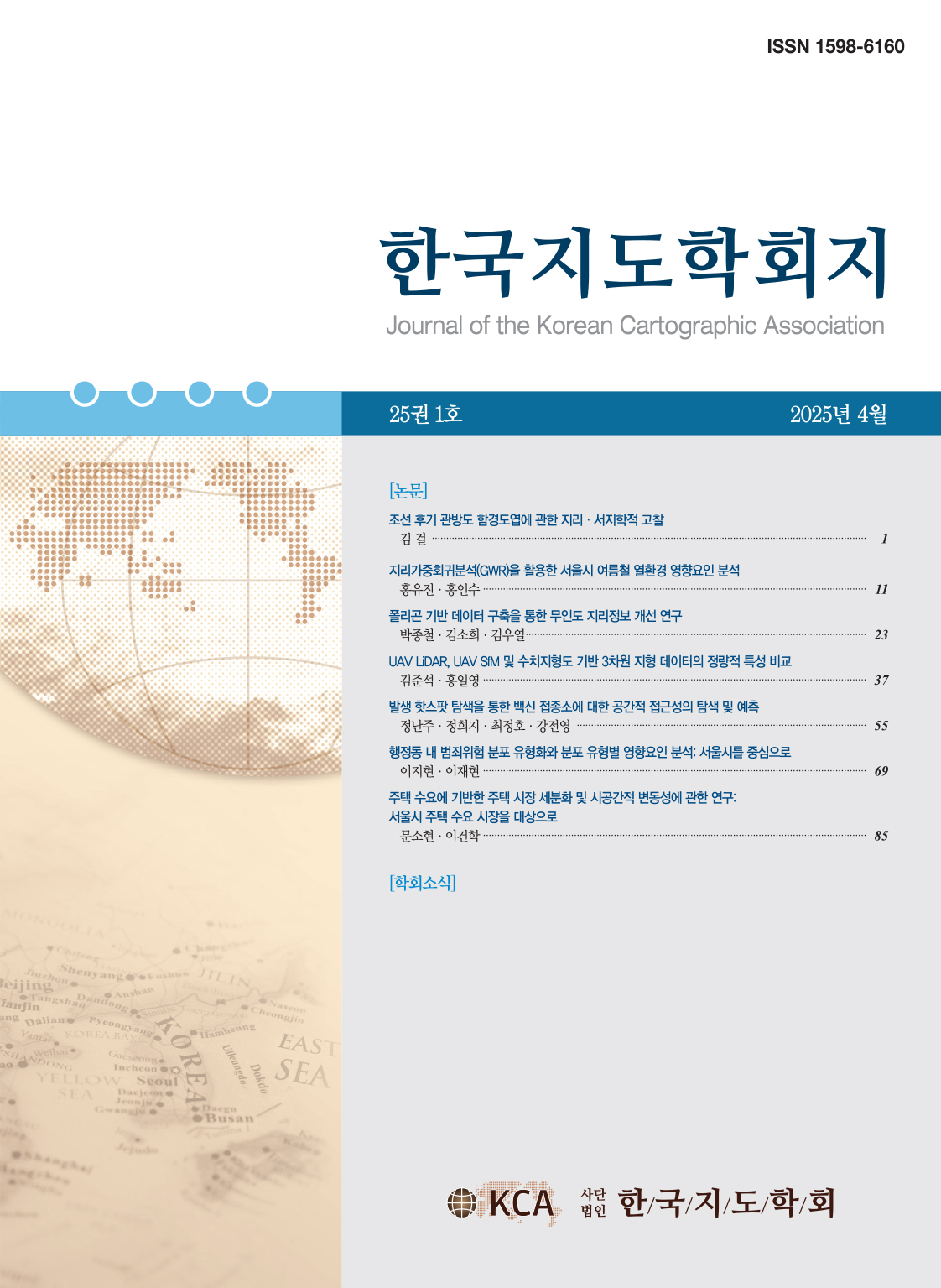Research Article
Abstract
References
Information
Residents’ perception of the urban built environment is an important factor in urban studies, urban planning, and urban design. Perceived fear of crime is a psychological measure of fear about the likelihood of a crime occurring in a particular place and for a particular crime, which is a subjective assessment by the individual. Fear of Crime is increasing faster than the actual crime rate, so identifying areas where people feel fear of crime is an effective and important process for crime prevention. However, previous studies have been limited by relying on surveys or fieldwork with a small number of people and a limited scope. The purpose of this study is to measure and visualize the fear of crime felt by citizens using street view images and deep learning technology, and the study area is Yeongdeungpo-gu, Seoul. In order to measure fear of crime using street view images, it is necessary to measure people’s fear of crime on street images and build a model to predict the evaluation score using a deep learning model. For this study, we collected street view images using Kakao Map API. Using 20,886 street view images from the collected images, we built a training data set of 171,942 images that ask users to respond to which street they feel relatively unsafe. After training the Global-Patch-RSS-CNN model with the constructed pairwise comparison data set, the trained model was applied to the entire study area to derive and visualize the prediction score of fear of crime. This study is significant in that it presents the first case of measuring urban fear of crime using street view images and deep learning technology, and it can contribute to effective urban planning and crime prevention strategies by analyzing the environmental characteristics of areas with high fear of crime.
거주민의 도시 건조환경(Urban Built Environment)에 대한 인식은 도시연구, 도시계획 및 도시설계에 중요한 요소이다. 범죄불안감이란 특정 장소와 특정 범죄에 대해서 느끼는 범죄 발생 가능성에 대한 불안감의 심리량을 의미하는데, 이는 개개인의 주관적인 평가이다. 범죄불안감은 실제 범죄율보다 빠르게 증가하고 있어, 사람들이 범죄불안감을 느끼는 지역을 찾는 것은 범죄예방에 효과적이며 중요한 과정이다. 하지만 기존 연구에서 도시 건조환경에 대한 불안감 측정은 소수의 사람과 제한된 범위를 대상으로 설문조사나 현장조사에 의존하여 제한적이었다. 본 연구의 목적은 거리영상과 딥러닝 기술을 활용하여 시민들이 느끼는 범죄 불안감을 측정하고 시각화하는 것이며 연구대상지역은 서울시 영등포구이다. 거리영상을 활용하여 범죄불안감을 측정하기 위해서는 거리영상에 대한 사람들의 범죄불안감을 측정하고, 이를 딥러닝 모델을 활용하여 평가점수를 예측하는 모델을 구축해야 한다. 이를 위해 본 연구에서는 카카오맵 API를 활용하여 거리영상을 수집하였다. 수집한 영상 중 20,886장의 거리영상을 활용하여 상대적으로 불안감을 느끼는 거리가 어느 쪽인지를 응답하도록 하는 171,942개의 훈련데이터 셋을 구축하였다. 구축된 쌍별비교 데이터 셋으로 Global-Patch-RSS-CNN모델을 훈련 후, 훈련된 모델을 연구대상 지역 전체에 적용하여 범죄불안감 예측점수를 도출하고 시각화였다. 본 연구는 거리영상과 딥러닝 기술을 활용하여 도시의 범죄불안감을 측정하는 첫 사례를 제시하였다는 점, 그리고 범죄불안감이 높게 평가되는 지역의 환경 특성을 분석하여, 효과적인 도시 계획 및 범죄 예방 전략 수립에 기여할 수 있다는 점에 의의가 있다.
- 강영옥, 2023, “GeoAI 활용분야와 연구동향,” 대한지리학회지, 58(4), 395-418. https://doi.org/10.22776/kgs.2023.58.4.395 10.3917/pro.395.0058
- 김의명・홍송표・박진이, 2019, “연속수치지도와 유동인구를 이용한 범죄취약 추정지역 추출,” 한국지도학회지, 19(1), 59-68. https://doi.org/10.16879/jkca.2019.19.1.059 10.16879/jkca.2019.19.1.059
- 김지연・강영옥, 2022, “거리영상 기반 보행환경의 정성적 평가 예측을 위한 딥러닝 모델 개발,” 대한공간정보학회지, 30(2), 45-56. https://doi.org/10.7319/kogsis.2022.30.2.045 10.7319/kogsis.2022.30.2.045
- 김환성・정혜진・이제승, 2020, “범죄예방 환경설계(CPTED) 적용이 저층 주거지역 거주민들의 범죄불안감에 미치는 영향 - 서울시 주민참여형 재생사업 대상지를 중심으로 -,” 한국 문화공간 건축학회 논문집, 69, 165-176.
- 노지현・박부미, 2017, “셉티드 지표를 활용한 지역의 범죄 불안감 연구: 골목길 경관요소를 중심으로,” Journal of Integrated Design Research, 16(4), 91-104.
- 박지영・강영옥・김지연, 2022, “거리 영상과 시멘틱 세그먼테이션을 활용한 보행환경 평가 지표 개발,” 한국지도학회지, 22(1), 53-68. https://doi.org/10.16879/jkca.2022.22.1.053 10.16879/jkca.2022.22.1.053
- 박현수, 2018, “범죄 두려움에 영향을 미치는 요인의 공간 분석,” 형사정책연구, 29(2), 91-117.
- 서울지방경찰청, 2021, 「2021 5대 범죄 발생현황」.
- 서울특별시, 2013, 「범죄예방환경설계(CPTED) 가이드라인」.
- 서울특별시, 2021, 「2021 도시정책지표조사 보고서」.
- 안재경・최이문, 2023, “범죄두려움 측정 개선방안에 대한 연구: 정서와 인지적 평가로서의 범죄두려움,” 형사정책연구, 34(1), 105-140. https://doi.org/10.36889/KCR.2023.3.31.1.105 10.36889/KCR.2023.3.31.1.105
- 우선희, 2018, “범죄 피해 불안과 인구사회학적 요인: 유럽국과의 비교를 중심으로,” 보건복지포럼, 2018(7), 66-80.
- 이경훈, 1998, “환경특성과 범죄의 두려움간의 관계에 대한 이론적 모델,” 대한건축학회논문집 계획계, 14(2), 23-36.
- 이유미・백혜선, 2008, “범죄로부터의 안전성 평가 지표와 범죄불안감간의 상관성 분석에 관한 연구,” 대한건축학회 논문집, 24(10), 121-128.
- 정진성, 이재열, 조병희, 구혜란, 안정옥, 2010, 「위험사회, 위험 정치」, 서울대학교출판문화원.
- 한국형사정책연구원, 2021, 「국민생활안전실태조사」.
- 한선희・이재용, 2015, “공간정보기반 지능형 방범 실증지구 선정방안에 관한 연구,” 한국지도학회지, 15(3), 101-111. https://doi.org/10.16879/jkca.2015.15.3.101 10.16879/jkca.2015.15.3.101
- Anderson, J.M., MacDonald, J.M., Bluthenthal, R., and Ashwood, J.S., 2012, Reducing crime by shaping the built environment with zoning: An empirical study of Los Angeles, University of Pennsylvania Law Review, 161(699), 699-757. 10.2139/ssrn.2109511
- Armitage, R., and Monchuk, L., 2019, What is CPTED? Reconnecting theory with application in the words of users and abusers, Policing: A Journal of Policy and Practice, 13, 312-330. https://doi.org/10.1093/police/pax004 10.1093/police/pax004
- Blečić, I., Cecchini, A., and Trunfio, G.A., 2018, Towards automatic assessment of perceived walkability, In International Conference on Computational Science and Its Applications, 351-365. https://doi.org/10.1007/978-3-319-95168-3_24 10.1007/978-3-319-95168-3_24
- Burges, C., Shaked, T., Renshaw, E., Lazier, A., Deeds, M., Hamilton, N., and Hullender, G., 2005, August, Learning to rank using gradient descent, Proceedings of the 22nd international conference on Machine learning, New York, USA, 89-96. https://doi.org/10.1145/1102351.1102363 10.1145/1102351.1102363
- Charlton, R.W. and Mistry, D., 2020, Factors that affect the perception of safety in 40 high crime areas in Gauteng province, International Journal of Humanities and Social Science Invention (IJHSSI), 9(3), 6-18.
- Clancey, G. and Fisher, D.G., 2016, Crime prevention through environmental design in New South Wales, Australian Planner, 53, 73-82. https://doi.org/10.1080/07293682.2015.1118392 10.1080/07293682.2015.1118392
- Cohen, D.M., 2014, CPTED (Crime prevention through environmental design). https://doi.org/10.1002/9781118517390.WBETC075 10.1002/9781118517390.wbetc075
- De Nadai, M., Vieriu, R.L., Zen, G., Dragicevic, S., Naik, N., Caraviello, M., and Lepri, B., 2016, Are safer looking neighborhoods more lively? A multimodal investigation into urban life, MM 2016 - Proceedings of the 2016 ACM Multimedia Conference, 1127-1135. https://doi.org/10.1145/2964284.2964312 10.1145/2964284.2964312
- Dubey, A., Naik, N., Parikh, D., Raskar, R., and Hidalgo, C.A., 2016, Deep Learning the City: Quantifying Urban Perception at a Global Scale, ArXiv, abs/1608.01769. https://doi.org/10.1007/978-3-319-46448-0_12 10.1007/978-3-319-46448-0_12
- Eun, J., 2020, (The) association between urban form and perceived safety of urban environment, Master’s thesis of City Planning, Seoul National University.
- Guan, W., Chen, Z., Feng, F., Liu, W., and Nie, L., 2021, Urban Perception: Sensing Cities via a Deep Interactive Multi-task Learning Framework, ACM Transactions on Multimedia Computing, Communications, and Applications (TOMM), 17(1s), 1-20. https://doi.org/10.1145/3424115 10.1145/3424115
- He, L., Paez, A., and Liu, D., 2017, Built environment and violent crime: An environmental audit approach using Google Street View, Computers, Environment and Urban Systems, 66, 83-95. https://doi.org/10.1016/J.COMPENVURBSYS.2017.08.001 10.1016/j.compenvurbsys.2017.08.001
- Jeffery, C.R., 1971, Crime prevention through environmental design, Beverly Hills, CA: Sage Publications. 10.1177/000276427101400409
- Joglekar, S., Quercia, D., Redi, M., Aiello, L., Kauer, T., and Sastry, N., 2020, FaceLift: a transparent deep learning framework to beautify urban scenes, Royal Society Open Science, 7(1), 190987. https://doi.org/10.1098/rsos.190987 10.1098/rsos.19098732218934PMC7029915
- Kang, Y., Kim, J., Park, J., and Lee, J., 2023, Assessment of perceived and physical walkability using street view images and deep learning technology, ISPRS International Journal of Geo-Information, 12(5), 186. https://doi.org/10.3390/ijgi12050186 10.3390/ijgi12050186
- Koch, G., 2015, Siamese neural networks for one-shot image recognition, Master’s thesis, University of Toronto, 8-11.
- Lee, I., Jung, S., Lee, J., and Macdonald, E., 2019, Street crime prediction model based on the physical characteristics of a streetscape: Analysis of streets in low-rise housing areas in South Korea, Environment and Planning B: Urban Analytics and City Science, 46, 862-879. https://doi.org/10.1177/2399808317735105 10.1177/2399808317735105
- Li, X. and Ratti, C., 2018, Mapping the spatial distribution of shade provision of street trees in Boston using Google Street View panoramas, Urban Forestry & Urban Greening, 31, 109-119. https://doi:10.1016/j.ufug.2018.02.013 10.1016/j.ufug.2018.02.013
- Li, Y., Yabuki, N., Fukuda, T., and Zhang, J., 2020, A big data evaluation of urban street walkability using deep learning and environmental sensors-a case study around Osaka University Suita campus, In proceedings of the 38th eCAADe conference, TU Berlin, Berlin, Germany, 319-328. https://doi.org/10.52842/conf.ecaade.2020.2.319
- Min, W., Mei, S., Liu, L., Wang, Y., and Jinag, S., 2019, Multi-task deep relative attribute learning for visual urban perception, IEEE Transactions on Image Processing, 29, 657-669. https://doi.org/10.1109/TIP.2019.2932502 10.1109/TIP.2019.293250231398119
- Roof, K. and Oleru N., 2008, Public health: Seattle and King county’s push for the built environment, Journal of Environmental Health, 71(1), 24-27.
- Salesses, P., Schechtner, K., and Hidalgo, C. A., 2013, The Collaborative Image of The City: Mapping the Inequality of Urban Perception, PLoS ONE, 8(7). https://doi.org/10.1371/journal.pone.0068400 10.1371/journal.pone.006840023894301pmcidPMC3722224
- Santani, D., Ruiz-Correa, S., and Gatica-Perez, D., 2018, Looking south: Learning urban perception in developing cities, ACM Transactions on Social Computing, 1(3), 1-23. https://doi.org/10.1145/3224182 10.1145/3224182
- Wang, R., Liu, Y., Lu, Y., Yuan, Y., Zhang, J., Liu, P., and Yao, Y., 2019a, The linkage between the perception of neighbourhood and physical activity in Guangzhou, China: using street view imagery with deep learning techniques, International journal of health geographics, 18(1), 1-11. https://doi.org/10.1186/s12942-019-0182-z 10.1186/s12942-019-0182-z31345233PMC6659285
- Wang, R., Liu, Y., Lu, Y., Zhang, J., Liu, P., Yao, Y., and Grekousis, G., 2019b, Perceptions of built environment and health outcomes for older Chinese in Beijing: A big data approach with street view images and deep learning technique, Computers, Environment and Urban Systems, 78, 101386. https://doi.org/10.1016/j.compenvurbsys.2019.101386 10.1016/j.compenvurbsys.2019.101386
- Wang, R., Lu, Y., Zhang, J., Liu, P., Yao, Y., and Liu, Y., 2019c, The relationship between visual enclosure for neighbourhood street walkability and elders’ mental health in China: using street view images, Journal of Transport & Health, 13, 90-102. https://doi.org/10.1016/j.jth.2019.02.009 10.1016/j.jth.2019.02.009
- Wang, R., Yuan, Y., Liu, Y., Zhang, J., Liu, P., Lu, Y., and Yao, Y., 2019d, Using street view data and machine learning to assess how perception of neighborhood safety influences urban residents’ mental health, Health & place, 59, 102186. https://doi.org/10.1016/j.healthplace.2019.102186 10.1016/j.healthplace.2019.10218631400645
- Widya Putra, D., Salim, W.A., Indradjati, P.N., and Prilandita, N., 2023, Understanding the position of urban spatial configuration on the feeling of insecurity from crime in public spaces, Frontiers in Built Environment, 9. https://doi.org/10.3389/fbuil.2023.1114968 10.3389/fbuil.2023.1114968
- Wilson, J.Q. and Kelling, G.L., 1982, Broken windows, Atlantic Monthly, 249(3), 29-38.
- Xu, Y., Yang, Q., Cui, C., Shi, C., Song, G., Han, X., and Yin, Y., 2019, Visual Urban Perception with Deep Semantic-Aware Network, In International Conference on Multimedia Modeling, 28-40. https://doi.org/10.1007/978-3-030-05716-9_3 10.1007/978-3-030-05716-9_3
- Zhang, F., Zu, J., Hu, M., Zhu, D., Kang, Y., Gao, S., and Huang, Z., 2020, Uncovering inconspicuous places using social media check-ins and street view images, Computers, Environment and Urban Systems, 81. https://doi.org/10.1016/j.compenvurbsys.2020.101478 10.1016/j.compenvurbsys.2020.101478
- Zhou H., He, S., Cai, Y., Wang, M., and Su, S., 2019, Social inequalities in neighborhood visual walkability: Using street view imagery and deep learning technologies to facilitate healthy city planning, Sustainable Cities and Society, 50. https://doi.org/10.1016/j.scs.2019.101605 10.1016/j.scs.2019.101605
- Zhou, H., Liu, L., Lan, M., Zhu, W., Song, G., Jing, F., Zhong, Y., Su, Z., and Gu, X., 2021, Using Google Street View imagery to capture micro built environment characteristics in drug places, compared with street robbery, Computers, Environment and Urban Systems, 88. https://doi.org/10.1016/j.compenvurbsys.2021.101631 10.1016/j.compenvurbsys.2021.101631
- Publisher :The Korean Cartographic Association
- Publisher(Ko) :한국지도학회
- Journal Title :Journal of the Korean Cartographic Association
- Journal Title(Ko) :한국지도학회지
- Volume : 24
- No :1
- Pages :71~84
- DOI :https://doi.org/10.16879/jkca.2024.24.1.071



 Journal of the Korean Cartographic Association
Journal of the Korean Cartographic Association





